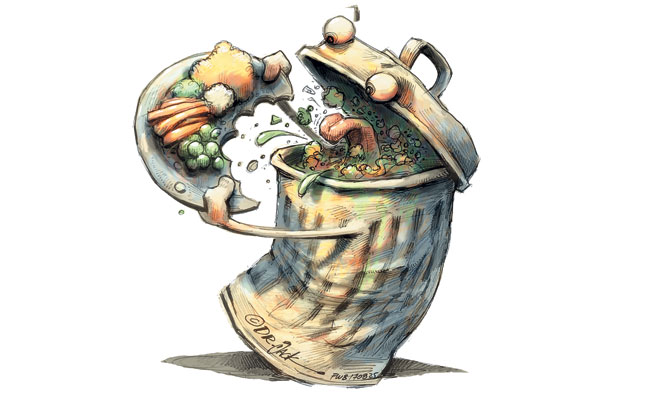
Photo: Dr Jack
Estimates suggest that about 10 million tons of food go to waste in South Africa every year. This accounts for a third of the 31 million tons of food produced annually.
The losses comprise 44% fruit and vegetables, 26% grains, 15% meat, and 13% roots, tubers and oilseeds.
Most of this wastage and loss occurs early in the food supply chain, where 50% is lost during the post-harvest phase, 25% during processing and packaging, 20% during distribution and retail, and 5% at consumer level.
Case studies
In 2015, the WWF-SA conducted a study of food retailer Woolworths’ value chain to investigate the extent of food waste.
Tracking one product group, namely spinach (both baby spinach and Swiss chard), through the supply chain, the organisation found that the highest level of potential food loss occurred on the farm, where, in extreme cases, up to 60% of the crop could be lost.
According to research, primary causes of food waste at farm level is damaged harvests and over-planting.
In the processing stage, waste is usually caused by quality problems and size variations. WWF-SA, again in partnership with Woolworths, participated in the pilot phase of the World Resources Institute (WRI) food loss and waste accounting and reporting standard.
The pilot aimed to test a methodology to map food loss and waste along the food chain.
The researchers selected spinach because of the product’s high risk of waste throughout the chain. The results showed that the greatest wastage occurred at the production and processing stages. Of the initial 100g of spinach produced on the farm, only 26g ended up being eaten.
All the rest were lost: 26g before the product left the farm, 38g during packaging and processing, 3g in retail distribution, and 7g in-store.
A financial burden
The Council for Scientific and Industrial Research (CSIR) calculated that the financial burden of food loss and waste in South Africa is roughly 2% of the national GDP, while in 2012, Nahman et al found that roughly 0,8% of the national GDP is wasted by households in the form of food waste every year.
A WWF study in Rustenburg in North West, found that the weight of food waste as a percentage of the total weight of domestic waste collected at various households was 27% in low-income areas, 13% in middle-income areas, and 17% in high-income areas.
Waste, greenhouse gas emissions and climate change
Although food waste has become a major concern for all countries, limited attention has been paid to the environmental and economic cost of food waste.
When studying the environmental effects, researchers focused on the percentage of greenhouse gas (GHG) emissions caused by the activity; the higher the percentage, the greater the damage.
The emissions levels were measured in two ways: first, the relatively minor impact of the decomposition of food waste in landfills; secondly, the emissions associated with food production, transport and retail, or the ‘life cycle’ view of food waste.
As food production involves the use of energy, water and land, additional production means using more fresh water and fossil fuel-based energy, contributing to more GHG emissions. This extra production, in turn, creates more water waste and energy waste.
The energy wasted every year in South Africa to produce food that is never consumed is estimated at enough to power the City of Johannesburg for roughly 16 weeks.
The wasted water would fill over 600 000 Olympic size swimming pools, meaning that about 1,7 billion cubic metres of ground and surface water, which is around a fifth of the total water used, goes to producing food that will be wasted.
Approximately 90% of waste in South Africa is disposed of in landfills, where it leads to the production of methane and carbon dioxide, greenhouse gases that contribute to climate change.
It has been shown that, over the course of a century, methane’s impact on the environment is 28 to 36 times greater than that of carbon dioxide.
Limited research
There are major research and knowledge gaps on global and local food waste, and information is therefore primarily obtained through estimations. Relevant research is particularly lacking on the causes and nature of food waste along the food supply chain, as well as on the accurate quantification thereof.
While many actions required to reduce food waste are already well formulated, the challenge is transferring this knowledge to government, business sectors and households.
As a signatory of the United Nations’ Sustainable Development Goals, the South African government, represented by the Department of Agriculture, Forestry and Fisheries, has made a global commitment to halve the country’s food waste by 2030, according to which it is now obligated to create the political and social environments conducive to adopting food waste mitigation strategies.
Educating consumers about waste
South Africa has no legislation governing food waste, and existing legislation generally covers waste and waste management.
However, social media is a useful medium to educate consumers on reducing food waste by consuming leftovers, and storing food effectively, amongst others.
Other important waste management efforts include: fit-for-purpose packaging, food donations, and promoting supply chain efficiency, as well as sustainable farming and food production.
The views expressed in our weekly opinion piece do not necessarily reflect those of Farmer’s Weekly.
For more information, contact WWF-SA on 021 657 6600 or 011 339 1152. View the full report at awsassets.wwf.org.za











